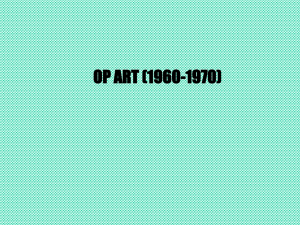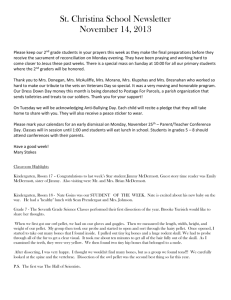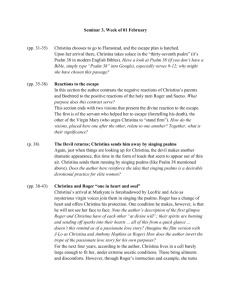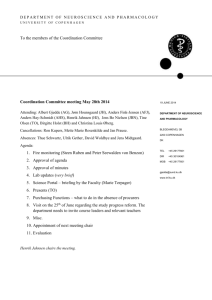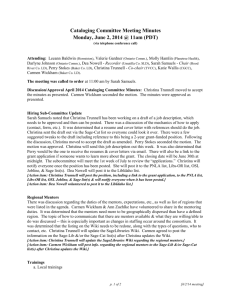Queen Christina`s Rome
advertisement
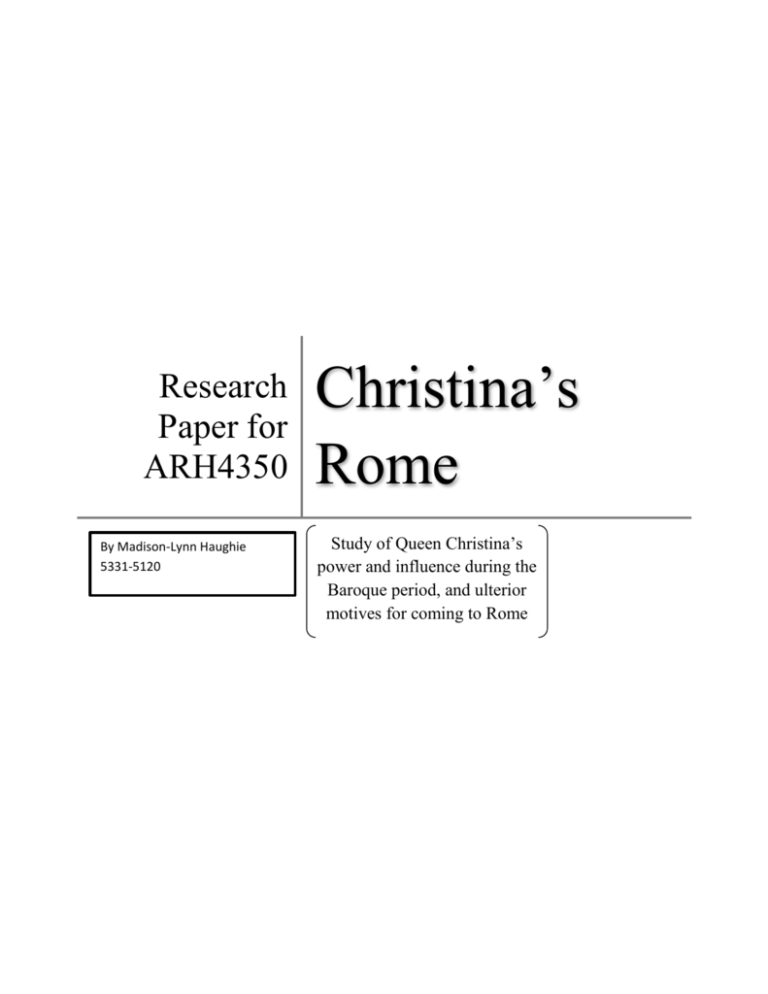
Research Paper for ARH4350 By Madison-Lynn Haughie 5331-5120 Christina’s Rome Study of Queen Christina’s power and influence during the Baroque period, and ulterior motives for coming to Rome Madison Lynn Haughie 1 Research Paper for ARH4350 Historians have not been kind to women. For example, we knew virtually nothing about female artists of the past until the modern era, and even then their histories are now scarce and their art uncredited or lost. Once upon a time, when a woman wished to write or express her opinion she had to do so under aliases and in secret because that was not her 'function' in society. Unless you were in poverty or lived on a farm, a woman wasn’t expected to lift a finger in any capacity outside the house. It is really refreshing when we see documented histories of important woman figures. Sometimes we are lucky enough to know as much about a ruling Queen as we do a King. But this paper isn't about feminism or powerful female monarchs or the gender bias of Historians in the art world. This is about an exiled Queen who came to Rome and was greeted with some of its most powerful citizens at her feet. Here I will focus on the life, influence, and patronage of Queen Christina of Sweden in Baroque-era Rome. Her accomplishments and achievements really speak for themselves. It is important to note though that many of her commissions don't exist physically anymore (they only exist in documents) so we have to rely a bit on archival records. So how was it that an exiled Queen was able to come to the epicenter of the Baroque period and have such a profound influence on Rome and an era? Figure 1 Christina by Sebastien Bourdon Madison Lynn Haughie 2 Research Paper for ARH4350 The circumstances of Christina's childhood were interesting, to say the least. Her mother was a German princess of Brandenburg, and there was an intense pressure for her to bear a male heir for the King of Sweden1. Her father was Gustavus Adolphus, who was ranked by military historians as one of the five greatest generals of all time2. When Christina was born December 1626, she is Figure 2 Gustavus Adolphus at the Battle at Breitenfeld by Unknown said to have been completely covered with hair and was originally mistaken as a boy out of the womb. It was Princess Caroline, the King's sister that told him of Christina’s true nature. Luckily, Gustavus wasn’t as backward as some of the other men of his time. His response was to hug his sister and say : "Let us thank God. I hope this girl will be as good as a boy to me. May God preserve her now that He has sent her!"3 He treated the birth of his daughter just as he probably would have a son. She was his only heir, his successor, so she had to be brought up like one. And while her relationship with her father was said to have been strong, her mother seemed to care little for her. As evidence, Christina would later write about her mother, saying: "She could not bear to see me, because I was a girl, and an ugly girl at that. And she was right enough, for I was as tawny as a little Turk."4 1 Marria Eleonora miscarried in 1621, gave birth to a baby girl in 1623 that died in her first years, and had a stillborn birth in 1625. 2 Haythornthwaite, Philip. Invincible Generals. Cambridge, Massachusetts: Da Capo Press, 1994. Print. 3 Orr, Lyndon. Famous Affinities of History (lndyPublish.com, 2003) 4 Orr, Lyndon. Famous Affiniti es of History (IndyPublish.com, 2003) There are different theories to why Christina's mother did not give her attention. One is that she was jealous of the attention the King gave to her. Another is that she was upset herself that her only child was not a boy. Madison Lynn Haughie 3 Research Paper for ARH4350 Unfortunately, the Battle of Lutzen5 would make Christina the Queen of Sweden at the shockingly young age of six. Her mother, now widowed, is said to have hung her husband's heart above the bed in which she and her daughter slept. Christina would of course Figure 3 Battle of Lützen by Carl Wahlbom not be crowned because of her youth and instead a council of ministers ran the country and continued the policies of the late King while she was educated in state affairs. She was taken away from her mother not long after her father’s death, as her mother was deemed unfit to raise a sovereign. Her education made her as impressive as her personality. Johannes Matthiae, the court chaplain, tutored her in philosophy, theology, mathematics, and astronomy. She was gifted with languages; at the time of her coronation she spoke Swedish, German, Dutch, Danish, French and Italian. She invited many gifted scholars to her court, including Johan Freinsheimus (a German philogist), Nicolaas Heinsus (Dutch scholar of Latin), and Blaise Pascal (a mathematician). Pascal was actually the inventor of one of the first calculators, which he presented to Queen Christina in 16526. 5 Battle of Lutzen occurred during the Thirty Years' War that was a victory for the Protestants and ended the Catholic threat to Saxony. 6 Zirpolo , Lilian . "Christina of Sweden's Patronage of Bernini: The Mirror of Truth Revealed by Time." Woman's Art Journal Spring-Summer 26.1 (2005): 38-43. JSTOR. The numerical wheel calculator was called the Pascaline and was meant to help his father a French tax collector count taxes. Madison Lynn Haughie 4 Research Paper for ARH4350 Before she was sixteen she was believed to be ready to take over, but she declined. Throughout her life she dressed the part of a king, such as wearing armor and carrying a sword around her troops. She is claimed by historians not to be very pretty or feminine, but greatly respected for her wit and intellect. Some believe she was a lesbian. Others say that it was possible she was a hermaphrodite, and her body was even exhumed to be tested. Results were inconclusive because of the body’s age. But none of that is important. What is important is that the fact that Christina had so much freedom as a child is what turned her into such a respected authority later on in life. At the age of eighteen she finally consented to being crowned. However, she made it very clear she would not marry. Upon assuming the throne, she ruled by her own opinion and will, taking strong stances unexpected even from her. Queen Christina would go against her adviser's advice, as well as the popular opinion of the people, and bring an end to the Thirty Years' War7 with a series of peace treaties known collectively as the Peace of Westphalia. At twenty-two, she had ended a long struggle without any sacrifice to her country. Christina was not a woman who would accept anyone else's opinion over her own, and cared little for what people thought of her or what was "proper" of a lady of the time. The way she demonstrates herself in early life will help us understand later why she was so well regarded as well as explain some of her actions in the future. Despite her stance on the Thirty Years’ War, the Swedes did love her, and she most definitely loved them. In her autobiography, she said this about them: “With its victorious 7 The Thirty Years War was a series of declared and undeclared wars through the years 1618-1648 throughout central Europe. The opponents were, on the one hand the Habsburg Holy Roman Emperors Ferdinand II and Ferdinand III together with their Spanish cousin Philip IV. Their opponents were the Danish, the Dutch, the French and of course the Swedes. Madison Lynn Haughie 5 Research Paper for ARH4350 weapons, this people subdued Germany, followed by England, France and Spain, and even glorious Italy must ultimately fall under its yoke, not to mention much of Asia and Africa.”8 But she felt her duties as Queen thwarted her intellectual pursuits and Sweden's Protestantism smothered free thinking. Finally she had enough and did the unthinkable of her time. On June 6th 1654, at the age of eighteen, she abdicated the throne and left her cousin, Karl Gustav, as her successor. After a tour across Europe, she headed for Rome. There are a variety of reasons of why she is believed to have decided to Rome and not any of the other areas of Europe she had toured. The most popular taught is because she wished to switch from Protestantism to Catholicism, and Rome was as Catholic as you get of the time. I believe that there is another reason though, much less simplistic. When Christina abandoned her title as Queen of the Swedes, I do not believe she completely threw away her Swedish upbringing. You see, from the Late Middle Ages and on, the Swedes had associated themselves with the Goths, the conquerors of Rome9. According to the 6th-century Gothic historian Jordanes, the Goths came from Sweden across the Baltic Sea to the basin of the Vistula River. By 300 AD they had migrated as far south as the lower Danube, around the Black Sea. They captured Athens in 267 and for about a century, wars between the Romans a nd Gothic rulers devastated the Balkan territory and the northeastern Mediterranean region. In 375, the Huns swept into Europe from Asia and conquered the Ostrogoths (“East Goths”), and forced the Visigoths (“Good Goths”) to seek refuge across the Danube within the boundaries of the Roman Empire. In 378, the Visigoths murdered Eastern Roman Emperor 8 9 "Queen Christina of Sweden." Lesbian News 24.10 (1999): 52. Academic Search Premier. Web. 30 Nov. 2012. The Goths are also believed to be the first of the Germanic peoples to become Christians. Madison Lynn Haughie 6 Research Paper for ARH4350 Valens. When Emperor Theodosius passed in 395, they rose in rebellion under the young King Alaric (Figure 4) and overran a large part of the Eastern Empire10. The entire Roman Empire fell into the hands of the Visigoths in 410. Justinian I and his Eastern Roman Empire generals would reconquer Italy (and Rome) in 526, but the Goths still received bragging rights for conquering Rome and holding control for over a hundred years. So what does this have to do with Christina besides the fact that the Goths were originally from Sweden? Figure 4 A depiction of Alaric I by Ludwig Thiersch. Gustavus Adolphus, Christina’s father, was a big advocate of “göticismen”11. Gothicism is a cultural movement that emphasizes on nationalistic pride and glory of Swedish ancestors the Geats (who were identified with the Goths12)13. Though Gustavus was a brilliant general and regained much of the lost Protestant territory during the Thirty Years War, he did not succeed in defeating Catholic forces entirely. Christina upon seeing the toll the war had on her country, 10 "Goths." International World History Project: World History From The Pre-Sumerian Period To The Present. World History Project, n.d. Web. 1 Dec 2012. http://history-world.org/goths.htm 11 Gothicism in Swedish 12 "Goths." International World History Project: World History From The Pre-Sumerian Period To The Present. World History Project, n.d. Web. 1 Dec 2012. http://history-world.org/goths.htm 13 Neville, Kristoffer. "Journal of the History of Ideas." Journal of the History of Ideas . 70.2 (2009): 213-234. Print. Madison Lynn Haughie 7 Research Paper for ARH4350 ended a battle neither she nor her father could win. But this goes entirely against her upbringing, raised up as a young “Spartan”, an ideal later reinforced by her reading of the heroic biographies of antiquity that she even describes in her biography: “Children of both sexes and of my age were brought together throughout the castle to play with me; my joy was to run, skip, dance, etc. But I could never stand dolls, and I had to draw on all my prudence not to hate an honourable man who gave me a magnificent present of that species. My dolls were pieces of lead with which I learned how to wage war. These pieces formed a little army that could be lined up for battle on a table with its retinue of complete artillery. I had small ships that were equipped for war, small forts of thick paper – all to teach me everything I needed to know about war, the navy and the science of fortifications. I revelled in these trifles during my leisure hours and the days when I did not devote myself to more serious studies. In all my games and diversions, my feelings were powerful and impetuous, and everything I desired called forth my persevance and strength. But I was reasonable and conciliatory whenever someone could persuade me that I had been mistaken.”14 14 "Queen Christina of Sweden." Lesbian News 24.10 (1999): 52. Academic Search Premier. Web. 30 Nov. 2012. Madison Lynn Haughie 8 Research Paper for ARH4350 Militaristically isn’t the only way you can control a city, though. Maybe Christina was seeking more intellectual pursuits and to be let off the pressures of being Queen and bearing an heir. But maybe she also thought she could go to Rome and become heavily involved in Roman culture and politics, taking (in a way) control of it that a Swede hadn’t done since the Goths. After all, nothing excited the Romans more than having a Protestant Queen convert to their Figure 5 Christina of Sweden by Jacob Ferdinand Voet Catholic religion. So much so that months of preparation went into her arrival… Rome was a buzz of activity as they prepared for the Queen's arrival. Unlike the Swedes who were in despair, Romans were excited. Pope Alexander VII commissioned Bernini to design her carriage and refurbish the Porta Del Popolo15. As the head the Catholic Church and being that Christina gave up her country's Protestant ideals for Catholicism, it is understandable in a way to why the Pope commissioned such things for her arrival. A strong woman who had great influence while in power of one of the most prosperous countries in Europe was "changing sides", if will. While Christina left because of the intellectual restraints put on her by her Protestant court, it looked as though she was abandoning everything for her faith (or at least spun that way to the citizens of Rome). Perhaps the Pope was rewarding her for the publicity she generated. After all, the Protestants and Catholics did not really get along during this time period. 15 Porta del Popolo was built in the 1500s by Pope Pius IV and designed by Nanni di Bigio. It was the entrance to Rome from Via Flaminia- the road leading to the Adriatic Sea that was built in 220 BC. Madison Lynn Haughie 9 Research Paper for ARH4350 They were always trying to avoid being like the other. She officially entered the city on December 23rd 1655. What is most special about this day is that after her procession Count Montecuccoli introduced the Queen to Bernini. "If there is anything bad, it is mine." Bernini said to her after introductions. She is said to have replied: "Then there is nothing of yours."16 This conversation would strike up friendship between the two as well as lead to Christina becoming his eager patroness until his death in 1680. Queen Christina’s arrival in Rome was not just focused on by the Catholic Church. It also prompted the Barberini's to honor her by staging three operas in the theater of the family's palace. The three operas were ll Trionfo Della Pieta ovvero La Vita Humana on January 31st 1656, and Dal Male il Bene and Le Armi e gli Amari in February. Giostra Figure 6 Clement IX by Carlo Maratta delle Caroselle, an occasion of pageantry, jousting, and music was held on the evening of February 28th 1656 for her at the palace as well17. The music of the three operas was by the composer and harpist Marco Marazzoli, and the libretto 18 by Monsignor Giulio Rospigliosi19. 16 Zirpolo , Lilian. "Christina of Sweden's Patronage of Bernini: The Mirror of Truth Revealed by Time." Woman's Art Journal Spring-Summer 26.1 (2005): 38-43. JSTOR 17 Batorska , Danuta. "Grimaldi's Designs for the Sets of "II Trionfo Della Pieta Ovvero La Vita Humana"" Master Drawings Spring 32 . 1 (1994): 40-49. JSTOR 18 Libretto is the text of a dramatic musical work, such as an opera. 19 Giulio Rospigliosi was a well-known libretti writer and would eventually go on to become Pope Clement IX Madison Lynn Haughie 10 Research Paper for ARH4350 It is interesting how the arrival of a single woman prompted such a surge of creative activity in Rome that transfigured into four distinct special events. Not one, not two, but three operas were commissioned in celebration and dedication to a mere woman. I say mere because the majority of women of the time, even in the city of Rome, did not have the kind of influence Christina has demonstrated. The city was literally throwing a party for her. The Opera's weren’t just something thrown together, like a lone figure in the middle of an empty stage belting out indescribably high notes to a crowd of aristocrats. No, there were detailed drawings for example that had to be made and approved before created into intricate sets for the Operas. Figure 7 and Figure 8 Grimaldi sketch of prologue and first act of the Il Trionfo della Pieta (left). Galestrui etching of prologue and first act of the Il Trionfo della Pieta (right) One of the major set designers was Giovanni Francesco Grimaldi. Grimaldi is more known to us in the modern day as a major decorator and landscape painter then a designer of theatrical sets and interiors. However, during his life, Grimaldi was renowned in all of these areas. Trionfo della Pieta were designed by him, and he co-designed the sets of Le Armi e gli Amari with Giovanni Maria Mariani. He also designed the arena for the joust , the cars and Madison Lynn Haughie 11 Research Paper for ARH4350 costumes of the riders, and dresses of the servants20. Today, Grimaldi has only four preparatory sketches of the II Trionfo della Pieta published, and a fifth is located in the British Museum. There are also three drawings in the Manuscript Room of the Biblioteca Apostolica Vaticana that are believed to be the final designs of the II Trionfo della Pieta sets. It is interesting to note that not only were the sets created for the Opera that celebrated Queen Christina's arrival, but the spaces they were in were also dedicated to her. To explain, we will look at the first drawing of three from Biblioteca Apostolica Vaticana. It was drawn on paper with pen and ink over Figure 9 Modern Day Barberini Theater, now a museum black chalk and depicts the prologue and first act of the Il Trionfo della Pieta. But the scenery is not what needs to be focused on. No, what we need to look at what is at the top of the drawing: the coat of arms of Queen Christina flanked by female figures (Figure 7). It is even better visible in Giovanni Battista Galestruzzi’s etching (Figure 8) based off the drawing. Queen Christina's coat of arms actually appeared on the proscenium arch of the Barberini theater (Figure 9). So not only did the Barberini’s prepare for her arrival with entertainment and festivities, but also built an entire theater dedicated to her that would house these events. This truly shows just how much of an effect Queen Christina had on 20 Batorska , Dan uta . "Grimaldi's Designs for the Sets of "II Trionfo Della Pieta Ovvero La Vita Humana"" Master Drawings Spring 32. I (I 994): 40-49. JSTOR Madison Lynn Haughie 12 Research Paper for ARH4350 Rome, where an affluent family commissions an entire building for the sake of having somewhere to celebrate her arrival and then actually include allusions of her in the architecture. Bernini is a likely candidate to have designed it; it was an open-air theater built on the side of the palace and said to be able to hold upwards of three thousand people . So it wasn't just small addon to the palace, it was meant to grandeur effect. One must remember though that people did not just commission things in honor of her. Queen Christina was a patroness herself, and as hinted by the Barberini 's commissions, seemed to fancy the theater and Opera. In fact most records of her patronage that survives deals primarily with the theater. By 1666 she had already sponsored many operas in the city and had become a patron of Alessandro Scarletti. She was able to persuade Pope Clement IX, who had been the one to write the Operas to celebrate her arrival in Rome , to authorize the building of a public opera house. Called the Teatro Tordinoa, the commission was given to the architect Carlo Fontana and paid for by the advance sale of boxes. It was completed in 1670 and its opening was a performance of Cavalli's Scipione Africano21 . This is a perfect example of the kind of connections the Queen had and formed in Rome. She was so well regarded and had such a strong influence that she had her words in Pope’s ear. Without this influence, the project would have likely never seen the light of day. The Opera house would close in 1674, but reopen in 1695 completely remodeled by Fontana. 21 Forsyth, Michael. "The Development of the Opera House." Buildings for Music: The Architect, the Musician and the Listener from the Seventeenth Century to the Present Day. (Cambridge: Cambridge UP, I 985) Madison Lynn Haughie 13 Research Paper for ARH4350 Queen Christina wasn't only a patron of the theater, though. She also a great advocate of the fine arts, as exemplified by her commissions to Bernini. None of the works survive, but from Nicodemus Tessin's22 visit to her home at the Riario palace we know the extent of her patronage23. Among the artist's works he saw were a bust of the queen, two paintings, and a sculpted head of a child, a marble bust of Christ, and an elaborate mirror depicting "Truth Revealed by Time". The most important commission received from Christina was the mirror. There is a drawing of it by Bernini at Windsor Castle (Figure 10), and a drawing by Tessin depicting the finished design. But why was this mirror Figure 10 Design of Christina’s Mirror by Bernini so important? Some scholars suggest that the mirror was a memento mori24 meant to reveal the gradual decay of beauty and youth. But Christina was not the kind of women who focused on appearances, as she wrote: "There are those who are foolish as to become slaves and martyrs to their clothes and fashion. One is quite unhappy when spending every moment of one's life between a mirror and a comb.”25 Another theory is that Christina was attempting to help him regain credence after the fiasco over the towers of St. Peter’s. What had happened was that the first tower was built on an underground spring, which caused it to crack and it then had to be demolished. He was criticized rather harshly for his failure and his popularity fell greatly. 22 Swedish architect, the son of Tessin the Elder. The palace was tom down and rebuilt as the Palazzo Corsini in the 1700s. 24 "remember your mortality " 25 Zirpolo, Lilian . "Christina of Sweden's Patronage of Bernini: The Mirror of Truth Revealed by Time." Woman's Art Journal Spring-Summer 26. 1 (2005): 38-43. JSTOR. It is said that the Queen only took fifteen minutes to get ready every day. 23 Madison Lynn Haughie 14 Research Paper for ARH4350 Yet another theory is that the mirror was commissioned by Christina to reflect the feelings of her own scandal. Between 1656 and 1657, she was in France bribing Cardinal Mazarin into making her Queen of Naples after the country captured the region from Spain. Marquis Gian Rinaldo Monaldesco, Christina's equerry26, betrayed her by leaking this information to the Spanish. The result was the crumbling of her plans and Monaldesco's brutal execution. Had the plans gone through, Christina could have become one of the most powerful women in Europe, perhaps the world? Perhaps this is evidence of Christina’s following of Gothicism, trying to find a way to gain power/control over a Catholic state. Instead, she suffered a great public relations blow. There were writings of Monaldesco being her lover and throwing him away, of her being a hermaphrodite, arrogant, and pathological almost immediately in response to the execution. This did not go unnoticed by Christina, and though not concerned of her physical image and feminine standard, she was quite concerned with her public image. Her public image was really all she had. After all, at this point she was the adored "Patroness of Rome"27. There lies a connection between the mirror's themes, honesty triumphing over rumor, and how the exiled Queen felt about the situation. Even with the tarnish to her reputation and her unwarm welcome back to Rome, her influence was strong. In the early 1660s she was a recommendation for Bernini to Louis XIV for the design of the east facade of the Louvre. In 1670, when Bernini’s brother Luigi Bernini was accused of sodomizing a young boy, Christina intervened upon his behalf. Indeed, she appeared 26 An officer charged with supervision of the horses belonging to a royal or noble household. It was rumored that they were also lovers. The state of Christina’s sexual preference is unknown, as there were rumors of her being in contact with both sexes. 27 Zirpolo, Lilian . "Christina of Sweden's Patronage of Bernini: The Mirror of Truth Revealed by Time." Woman's Art Journal Spring-Summer 26.1 (2005) : 38-43. JSTOR Madison Lynn Haughie 15 Research Paper for ARH4350 to be close to Bernini, as evidence to a letter she wrote to Angelo Morosino in 1675: "I have such a high opinion of the said Bernini that I gladly take every opportunity to do him a good turn, for he has proved himself the greatest and most outstanding man of his craft who ever lived ."28 It is not strange that one of the most powerful artists of Baroque Rome would be allies with one of the most powerful women in the city. Upon Bernini's death, she even commissioned Baldinucci to write a biography of the artist.29 The last Pope Christina saw while alive was Innocent XI, who ruled from 1676 to 1689. He was far different from the other Pope's of her lifetime. He was a far more straight edge and strict ruler. In 1676 he shut down all of the Roman theaters and gambling houses. What is interesting is the confrontation Pope Innocent XI and Queen Christina had, and how glaringly it shows the power Christina had in Rome. Queen Christina, though voting in favor of the elimination of diplomatic sanctuary30, was angered when papal policemen actually entered her property to chase down a convicted man. She ordered her guards to rescue him from the sbirri31, who dared not challenge the Queen. Upon hearing of this event, the Pope's treasurer demanded that the captain of Christina’s guards, Landini, be brought to trial. Christina retorted that the sbirri had violated the boundaries of the "mini-kingdom” of her home (conquering an area of Rome?), writing: "To dishonor yourself and your master is then termed justice in your tribunal? I pity and despise you, now: but shall pity you much more when you become cardinal. Take my word that those, whom you have condemned to death, shall live, if it please God, sometime 28 Zirpolo, Lilian . "Christina of Sweden's Patronage of Bernini: The Mirror of Truth Revealed by Time." Woman's Art Journal Spring-Summer 26.1 (2005) : 38-43. JSTOR 29 Title: "The Life of Bernini ", published in 1682. 30 A special criminal law option available to persons who had just committed a crime, allowing them to seek refuge in a church or monastery, as well as another country/kingdom if taken in. 31 Proper name of the papal churches police force Madison Lynn Haughie 16 Research Paper for ARH4350 longer; and if they should die by any other hand than His, they shall not fall alone."32 As an act of rebellion, she armed her attendants and never left her home without her guards. Innocent's reaction was to simply terminate her papal pension, to which she wrote him thanking him "…for having removed from me such a subject of shame and humiliation.”33 Christina wanted to show that she did not need the backing of the Pope to have influence and financial security and that she was above him and those involved with the Papacy. Christina died in 1689. She left her expansive and impressive collection to Cardinal Azzolino. The Cardinal and the Queen appeared to have been very close; some say it was perhaps even a romantic relationship. Nevertheless, he arranged for her to be buried in the Basilica of St. Peter, an honor granted to only four other women: Queen Charlotte of Cyprus, Figure 11 Monument to Queen Christina in St. Peter’s Agnesina Colonna Caetani, Maria Clementina Sobieski, and Countess Matilda of Tuscany. Ironically, Pope Innocent XI himself officiated her funeral mass. Azzolino died only two months after her. Her collection was then left in the hands of Pompeo, who sold it in 1692 to Prince Livio Odescalchi. Odescalchi’s heirs would break up the collection, selling the paintings to Duke Philip of Orleans and the sculptures to Philip V of Spain. 32 33 Viva La Regina!"." Stupid Pope Tricks. (http://wavada.org, 2009). http://wavada.org/Ch20.php Viva La Regina!"." Stupid Pope Tricks. (http://wavada.org, 2009). http://wavada.org/Ch20.php Madison Lynn Haughie 17 Research Paper for ARH4350 Christina’s influence does not end with her death or her art collection, as she lives on through a variety of creative mediums. In 1849 Jacopo Foroni's wrote an opera about her called Christina, regina di Svezia which focused around abdication. August Strindberg wrote a play titled Kristina in 1901. In 1933 her life was deeply romanticized in the classic feature film Queen Christina. It starred Greta Garbo, depicting Christina as a heroine whose life deviated far from what we know about the real Queen. However, this film would lead to Christina becoming an icon for cross-dressing, transsexuality and lesbianism in our modern day age. Another film about Christina came out in 1974, The Abdication starring Liv Ullmann. In it Christina arrives in the Vatican and falls in love with Cardinal Azzelino. Finally, and most modern of all, Laura Ruohonen wrote Queen C in 2003 presenting her as woman “centuries ahead of her time”. Obviously Christina was indeed an influential figure in Europe, not just in her time but in our day in age as well. Christina is fascinating for being able to rise above perceived domestic roles of women during her lifetime and become a powerhouse in Baroque Rome. She stayed true to her word: she never married and she never had children. Never was she in a capacity that required her to stand (figuratively) underneath someone. Her power and influence is shown quite clearly through her relationship with several of the Popes that reigned during her lifetime and how her name is in history books and her ‘character’ depicted in various plays and films. However, she refused to ever grant anyone power over her, as shown by her confrontation with Pope Innocent XI. But it wasn't just her connections and relationships with high ranking officials and high-strung Madison Lynn Haughie 18 Research Paper for ARH4350 personality that made her have such a high capacity in the city. She had cultivated friendships with Baroque artists, most famously Bernini, and respected artistic talent as it if were as valuable as money and power. This is shown by her collection, that royalty themselves sought after. she was described by the Director of the National Museum of Fine Arts in Stockholm, as "one of history's greatest rebels and one of Sweden's first modern minds." Christina was indeed a powerful and influential figure that is important to the Baroque movement’s history and should never be overlooked. Madison Lynn Haughie 19 Research Paper for ARH4350 BIBLIOGRAPHY "Goths." International World History Project: World History From The Pre-Sumerian Period To The Present. World History Project, n.d. Web. 1 Dec 2012. http://historyworld.org/goths.htm History of the Gothic people – their lineage o Basis of Gothicism Goths = Swedes? Swede = Christina Haythornthwaite, Philip. Invincible Generals. Cambridge, Massachusetts: Da Capo Press, 1994. Print. Background information on Christina’s father Very Protestant, why would Christina become Catholic? Neville, Kristoffer. "Journal of the History of Ideas." Journal of the History of Ideas . 70.2 (2009): 213-234. Print. Background on Gothicism Cultural Movement in Scandinavia and Sweden Long-time beliefs Batorska, Danuta . "Grimaldi's Designs for the Sets of "Il Trionfo Della Pieta Ovvero La Vita Humana"" Master Drawings Spring 32. 1 (1994): 40-49. JSTOR. Web. 30 Nov. 2012. Points of interest to include in the paper: Barberini's commissioned plays and a festival-type event in her honor Set design was held in high regard, only the best for Christina What do the sketches tell us? They tell us about the original Barberini theater that no longer exists; Christina's coat of arms included in theater's architecture Background on Grimaldi, who designed the sets Writer of the Opera who became Pope-> Connection later to when Christina wanted to open a public Opera house Madison Lynn Haughie 20 Research Paper for ARH4350 Forsyth , Michael. "The Development of the Opera House." Buildings for Music: The Architect , the Musician and the Listener from the Seventeenth Century to the Present Day. Cambridge: Cambridge UP, 1985. Print. Information about the jousting festival, important to relate with Grimaldi from other source More examples of Christina 's delight in theater, wanting to open a public Opera house Show Pope connection How did she accomplish her goal? Fundraising by advance box sales Who would design the Opera house? What was the fate of the Opera house? Reactions from Rome? Orr, Lyndon. Famous Affinities of History. IndyPublish.com, 2003 . Famous Affinities of History . Philipp Lenssen , Oct. 2003 . Web . 6 Apr. 2012 . http://www.authorama.com /famousaffinities-of-history- i-S.html History of Christina Parents Childhood and Education: Treated like a male heir Abdication from the throne "Queen Christina Of Sweden." Lesbian News 24.10 (1999): 52. Academic Search Premier. Web. 30 Nov. 2012. Opinion on Christina’s sexual orientation Background information on her upbringing (gathering up several sources for this) Why did she convert? Madison Lynn Haughie 21 Research Paper for ARH4350 ""Viva La Regina!"." Stupid Pope Tricks . Http ://wavada.org , 2009. Web. 30 Nov. 2012. http://wavada.org/Ch20.php Christina 's relationship with the Popes Conflict with Innocent XI Buried in St. Peter's -> why was this important? Zirpolo , Lilian H. "Christina of Sweden's Patronage of Bernini: The Mirror of Truth Revealed by Time." Woman's Art Journal Spring-Summer 26.1 (2005): 38-43 . JSTOR. Web. 30 Nov. 2012 . Christina and Bernini 's relationship Two important people were close friends Commissions and patronage of Christina The Mirror and its meanings

